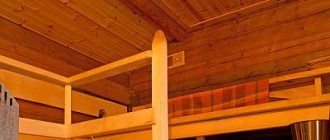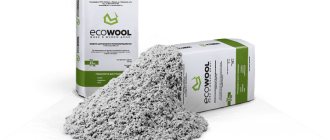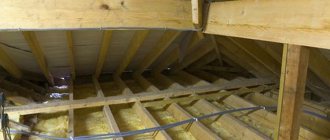Photo from the site: kaksdelatbanyu.ru Today many people are trying to have a Russian bathhouse in their homestead, and the easiest way is to build it yourself, then you can be absolutely sure that everything is done according to the technological process. Moreover, each stage of the device needs to be given a lot of time and attention so that everything works out as thoroughly as possible. Insulation also plays a significant role in this, and insulation of floor structures in the first place. True, you always need to start from the top, that is, from the ceiling, but a warm floor is simply of enormous importance.
The floor in a bathhouse is always exposed to particularly strong influences, ranging from sudden jumps and temperature changes to extreme humidity, which is also quite important. If you do not learn in time how to properly insulate the floor in a bathhouse with your own hands, you will soon notice significant heat loss, and, consequently, unnecessary energy consumption. But this is not the most important thing. Whatever the structure of your floor, no matter how well it is made, if it is not properly insulated and provided with ventilation, it will soon begin to collapse, which may even lead to the fact that you will have to start building everything from scratch.
Why is it necessary to insulate the floor in a bathhouse?
There is an opinion that insulating the floor in a bathhouse is an unnecessary and even harmful procedure. Proponents of this idea argue that it cannot be cold in a heated bathhouse. An example is a traditional Russian bathhouse, where the floor is an ordinary wooden flooring in one layer with cracks between the floorboards into which water flows.
In addition, installing a heat insulator creates conditions for premature failure of a wooden floor - a lot of water remains on it, mold, mildew, and rot appear.
There is some grain of truth in this point of view. However, the modern design of the bathhouse has changed significantly. In addition, new materials have appeared that are resistant to water and can withstand all biological damage.
Therefore, today floor insulation is a common stage of construction work (or reconstruction of an already finished bathhouse). A correctly performed procedure will significantly reduce fuel consumption during heating and reduce the amount of condensation on the floor after completing bath procedures.
In addition, the floor temperature is one of the indicators of microclimate and comfort - walking barefoot on a warm surface is much more pleasant than on a cold one.
Windows and doors
The process of insulating a wooden bathhouse from the inside also includes thermal insulation of door and window openings, since cracks in them will inevitably become sources of drafts and unnecessary heat loss. In order to reduce them to zero, the design of doors and windows itself must be thought out at the stage of design and construction of the bathhouse.
How to properly insulate a bathhouse: window openings
Even at the design and construction stages of a bath structure, it is necessary to think about the safe installation of windows. It is best to opt for sealed double-glazed windows, as this will ensure maximum insulation of the windows.
In the absence of the opportunity to install this type of windows, you should carefully consider inserting glass into existing ones.
It is recommended to use high-quality silicone sealant for this work.
Information. Installing windows slightly lower than their usual location will minimize heat loss.
Do not forget that the presence of a window in the bathhouse is simply necessary. This is due not only to concern for the health of bathhouse visitors, but also to the materials themselves, since without proper air exchange the appearance of fungus is simply inevitable.
Door
After a hot steam bath, bathhouse visitors go to the dressing room to get dressed and leave the room.
Some believe that insulating the walls inside the bathhouse and inside the dressing room is the only thing needed for a comfortable stay in it. However, this is not at all true. The fact is that an uninsulated door will allow drafts to pass through and will itself become a source of cold. When sweat flows from your face and a cold wind blows on your feet, you can get a cold.
Attention! It is worth remembering that it is undesirable to weigh the door too much, as this is fraught with sagging and further damage.
A very important question is how to insulate the partition in the bathhouse, as well as the doors in it. The insulation material must be lightweight, withstand temperature changes, as well as high air humidity.
Let's look at how to insulate a bathhouse door with your own hands using ecowool, since it is resistant to various temperatures and high humidity, and is also an environmentally friendly material.
For insulation you will need:
- Ecowool;
- Wooden blocks;
- Nails;
- Hardboard sheet.
According to experts, this is the most reliable way to insulate a bathhouse door.
The work is performed in the following sequence:
- First of all, wooden blocks are attached to the edges of the door so that a frame is formed. It should be located approximately 1-1.5 cm from the edge of the insulating sheet;
- Next, using nails, the ecowool sheet is nailed to the frame. It is worth noting that the insulation material must be rolled in two layers;
- A cavity should form inside the frame into which a sheet of hardboard must be placed;
- The door is covered with wooden paneling or other material.
If the insulation is installed correctly, when closing the door, a small part of the sheet should be placed on the door block, thereby completely eliminating the entry of cold air into the room.
When answering the question of how to insulate the front door in a bathhouse, let’s not forget about the jamb. The simplest way to insulate a jamb is to add insulation around the perimeter of the door. Felt is usually used for these purposes, but today there are a lot of more modern materials.
So, in order to insulate a door frame you need:
- Cut the insulation into thin strips;
- Cut a strip, the width of which should be at least 2 cm, to completely cover the internal perimeter of the jamb;
- The insulation, folded in two layers, is mounted at a minimum distance from the door leaf on the fold side. It must be secured with lath and nails.
Information. In 90 percent of cases, the ineffectiveness of a steam room is due to the gap between the door and the threshold.
This is why it is strongly recommended to install low doors with high thresholds.
Thermal insulation materials
There are many varieties of insulation with high performance qualities. However, not all of them can be used to insulate the floor in a bathhouse. The constant presence of water forces the screening out of permeable materials that tend to absorb moisture and thereby lose their working qualities.
Thermal insulation of the floor in the bathhouse is placed in such a way that all drains fall on it. You can try to protect the material with various films, but it is impossible to achieve one hundred percent effectiveness.
In addition, in hygroscopic types of insulation there is always some amount of water vapor present. It will be locked under the film and cannot be removed, and new portions of water will gradually enter from the outside. Sooner or later the insulation will get wet and stop performing its functions.
Therefore, for floor insulation, the best choice would be moisture-proof thermal insulation materials:
Styrofoam
Penoplex
Foamed polyethylene (these are different materials, about 90 items in total, but they all have the same properties)
Liquid polyurethane foam
These materials are equally resistant to moisture, but their performance properties are different. Let's take a closer look at them:
Styrofoam
The real name of this material is granulated polystyrene foam. The name “foam plastic” was preserved after the name of the company that first supplied this heat insulator to the USSR. However, it caught on and is now used by everyone. Polystyrene foam is an insulator made from sealed polystyrene foam granules.
They are combined in autoclaves in an atmosphere of hot steam. The resulting array is cut into sheets of a certain thickness. The material is light in weight and resistant to water (it has a negligible ability to absorb moisture in the amount of 1% of its own weight, after a day's stay in a container with water).
It is generally accepted that polystyrene foam does not burn. It's a delusion. The granules contain carbon dioxide, which prevents the sheets from burning. However, if the material melts, it can burn and will be very difficult to extinguish.
Of all types of thermal insulation, polystyrene foam is the cheapest. This became the reason for its popularity and demand among users.
Penoplex
This is the proper name for the thermal insulation material; from a chemical point of view, it is extruded polystyrene foam, the closest relative of polystyrene foam. It differs from its counterpart in greater density, strength, and also high cost.
High performance qualities made the material popular. Prices for it are gradually decreasing, increasing the demand and popularity of penoplex.
Foamed polyethylene
This is a relatively new material with advanced functionality and capabilities. There are about 90 types of polyethylene foam - isolon, penofol, isospan, tepofol, energyflex, porileks, etc. The abundance of names can be confusing, but in terms of quality and properties, many types are almost identical.
Polyethylene foam is produced in rolls, in the form of shells for pipes and in the form of bundles for insulating gaps. There are varieties with a foil surface that can reflect thermal (infrared) rays back into the room, improving the heating mode.
Expert opinion
Lovkachev Boris Petrovich
Bath master who knows everything about steaming
Polyethylene foam does not absorb or allow water to pass through at all, is lightweight and relatively thin. The potential of this insulator is great and has not yet been fully exploited; experts predict a great future for it. The popularity of the material is enhanced due to its relatively low cost and availability for the mass buyer.
Liquid polyurethane foam
This is a material that is a two-component liquid. When applied, it foams and increases in volume, resembling polyurethane foam. Applied by spraying using specialized equipment.
The advantage of the material is the ability to create a sealed insulation sheet applied to any surface - curved, convex or concave, with a mass of small parts, etc.
Virtually no preparation is required before application; even a wet surface can be coated (only without ice or frost). In addition, you can apply a layer of any thickness as required.
The disadvantages of liquid polyurethane foam are the high price and complexity of application. The need to use special equipment significantly limits demand, although all material indicators are very high and harmonious.
Where to order or buy
To implement a floor insulation project, it is possible to seek help from specialists, in particular from employees of companies involved in the construction of bathhouses. In addition, it is possible to do the thermal insulation work yourself; for this you will first need to buy suitable insulation, which is sold by the organizations collected in the corresponding section.
Share on social networks
Thank you for sharing such an original method of insulation, I’ll add it to my treasure chest!
Source
Which thermal insulator to choose?
The choice of suitable insulation is made taking into account various factors:
- subfloor material;
- design of the subfloor and water drainage system;
- room area;
- personal preferences of the owner and his financial capabilities.
Choosing a heat insulator is not so complicated, but requires careful consideration of operating conditions and possible loads. In principle, the main subject of consideration is usually the strength of the insulation, the ability to withstand possible loads. In this regard, all types of insulators behave differently.
Polystyrene foam under prolonged mechanical action crumbles and crumbles into individual granules. Penoplex wrinkles. Foamed polyethylene turns into a thin dense layer, and liquid polyurethane foam becomes denser and loses its porous structure.
In terms of the combination of price and performance qualities, penoplex is in the lead, and polystyrene foam is in second place.
Of all the factors, the material of the subfloor has the greatest influence. The most common types of floors are concrete and wood floors. Let's take a closer look at the ways to insulate them:
Insulation of a wooden floor
Most owners prefer wooden floors, as they correspond to the traditional idea of the design of bathhouse elements. Insulation of such a floor is carried out by laying a heat insulator over the subfloor.
In this case, you must first make a plank flooring and sew a vapor barrier underneath to protect the boards from contact with water vapor from the ground. In addition, it is necessary to think over a water drainage system and organize its drainage into the sewer or to a discharge point.
Thermal insulation is laid between vertical strips laid on edge. They act as joists for the finished floor and at the same time serve as sides for thermally insulated compartments. Penoplex slabs are laid tightly next to each other, the joints are glued with aluminum tape or filled with polyurethane foam.
A polyethylene film is laid on top of the insulation, which forms additional moisture protection for wooden parts. After this, you can begin laying the final floor covering (finish wood flooring).
Insulation of concrete floor
Insulation of a concrete floor is carried out according to the usual method for concrete floors and screeds. A waterproofing sheet (polyethylene or waterproof membrane) is laid on the rough concrete floor.
Then slabs of polystyrene foam or penloplex are placed tightly next to each other, immediately filling all the gaps with polyurethane foam.
After this, the pipes of the water drainage system are laid and the embedded parts of the drains are installed. Now you can start pouring the screed. Its thickness must be at least 50 mm to ensure sufficient strength. After the screed has hardened, the tiles are laid.
Tips for choosing insulation
The right choice of insulation is the key to success
The modern market offers a huge number of insulation materials. They differ from each other not only in their technical characteristics, but also in cost. However, you should not rely on the latter when choosing the best option.
The choice of insulation must be made based on:
- Type of flooring. Concrete floors are insulated with penoplex, expanded clay or perlite. The wooden floor is made of penoplex, as this is the only material that does not absorb moisture at all. It is undesirable to lay insulation with a fiber or open cellular structure under it, for example, expanded clay, since in this case it will be necessary to equip a reinforced layer of waterproofing. Penoplex can be replaced with foamed polymers - ecowool or Aisinin foam. Being light in weight, they retain heat well. However, electric, infrared or water heating can be installed under both concrete and wooden floors.
- The premises in which it will be installed. Organic insulation is suitable only for use in rest rooms or in the dressing room, since even treatment with fire retardants does not make them resistant to high temperatures.
- Personal wishes for safety - insulation can be organic and of plant or animal origin (felt, tow, cellulose) and inorganic (foam plastic, mineral wool and glass wool). The latter are produced through the processing of minerals and are characterized by resistance to high temperatures. However, they are inferior in environmental friendliness to organic insulation.
In addition, you need to pay attention to the specific gravity of the insulation itself. A good insulation is one that does not create additional load on the foundation.
Heated floor system
Warm floors in the bathhouse are a relatively recently used technique. Similar solutions were known back in the days of Ancient Rome, they were used in Turkish baths, but then were forgotten for a long time.
Today, heated floor systems are successfully used in bathhouses as a source of main heating, or as an additional element of comfort in “dry” sections (rest room, locker room, etc.). At the same time, the traditional heater is not canceled.
Only a water heated floor is suitable for a bathhouse - electric systems are not suitable either in design or in terms of economy. It should be connected to a boiler (gas or solid fuel), and a temperature control system (heating manifold) should be installed.
The system installation proceeds as follows:
- A waterproofing layer and a layer of heat insulation (foam plastic or penoplex) are laid on the floor.
- Place polyethylene film and reinforcing mesh. A polyethylene tube is fastened to it with nylon clamps - underfloor heating loops. The laying pattern is chosen so as to evenly cover the entire area of the room and bring the ends of the loops to the collector.
- The loops are connected to the collector, the functionality of the system is checked, and a concrete screed is poured to hide the tube. At the time of pouring, there must be water under pressure in it so that the screed does not flatten the hinges of the heated floor.
- When the screed has hardened, lay the floor covering.
Warm floor screed is the most effective design option. However, if the tube is damaged, you will have to break the screed and then refill it.
A few important points
Before we move on to considering materials for insulation, let’s decide what kind of floor will be in your bathhouse.
*We take as a basis the option that you do everything initially. Although, as I wrote above, you can redo the floors. The technology is the same, but the costs are higher.
Depending on the design of your steam room, you should also focus on insulation. After all, what is ideal for wooden floors is sometimes not suitable for concrete. However, this statement also works in the opposite direction. True, there are options that, if used correctly, will serve you equally well in both cases.
In addition, it is worth considering the structure of the floor itself. If the floor of your bathhouse is made according to the “leaky” design (which is most often found in the southern regions), then most likely you should not worry about its insulation. Well, “dry” and concrete floors require an individual approach.
Frequently asked questions
Some questions that users have can be answered immediately, without waiting for them to arise:
If the floor is wet, is it necessary to install a waterproofing layer over the moisture-proof insulation?
Despite the properties of the heat insulator, it is recommended to cover it with a film to cut off waste water. Over time, the film will develop a layer of slime and can simply be replaced without much expense or labor. It is not practical to change the insulation every year.
If mineral wool is chosen as insulation, how to protect it from water?
The usual technique is used - laying a waterproofing sheet, then mineral wool, on top of which is another layer of polyethylene.
If foil insulation is installed as thermal insulation, will the polyethylene sheet interfere with the passage of reflected infrared rays?
Polyethylene does not interfere with IR rays. However, it is not recommended to use black film; it can cut off some of the rays.
Is it possible to insulate a wooden floor with a layer of expanded clay backfill?
There are no fundamental objections to this matter. Many sources even recommend this option. However, you will have to carefully protect the backfill from water, which is technically difficult and ineffective.
How to lay drain system pipes?
As a rule, they are laid even before the installation of the heat insulator. When laying the pipes, they are covered with pieces of insulation and all cracks and joints are filled with foam, eliminating the possibility of cold bridges.
How to insulate a bathhouse with your own hands
A detailed analysis of how and with what you can insulate a bathhouse, which side is better (inside or outside), where to start and how to finish.
1. From the position of the location of the insulation
- External insulation of the bathhouse. When insulating a house, basement or garage, it has been proven that placing insulating material outside will be more effective. This allows you to protect the material from which the bathhouse is built. The roof of the bathhouse (attic) must be insulated if it is a separate building.
- Insulation of the bathhouse from the inside. The operating mode of the bathhouse is such that external insulation alone, with all its advantages, cannot be done. Moreover, in different rooms of the bathhouse it is necessary to maintain its own microclimate, humidity level and set temperature. Therefore, they begin to insulate the bathhouse from the inside. Moreover, suitable materials are chosen for each room, which in turn influence the choice of installation technology.
As you can see, the insulation process is complex.
2. From the perspective of the heat-insulating material used
There are different types of insulation materials available on the domestic construction market. Do not forget that a bathhouse can provide a healing effect only if natural and safe thermal insulation materials are used indoors.
Application of foam plastic
Many home craftsmen are interested in whether it is possible to insulate a bathhouse with foam plastic. After all, this is a relatively inexpensive and easy-to-use material. However, it should be said that the bathhouse can be insulated with foam plastic from the outside or along the foundation.
When asked whether it is possible to insulate a bathhouse with foam plastic from the inside, most experts will answer negatively. This is due to the fact that foam is easily destroyed when exposed to high temperatures. The low moisture resistance of this material causes it to rot under the influence of high humidity. Therefore, for the interior of a bathhouse, foam plastic can only be used in rooms where there is almost no moisture.
More about vapor barriers
The most successful vapor barrier option for all sauna rooms is aluminum foil. It is fire-resistant, durable, non-hygroscopic. The main advantage of aluminum foil is its ability to reflect heat. By using such a vapor barrier in a bathhouse, you can significantly reduce the consumption of fuel material.
Glassine and roofing felt cannot be used in the steam room, since these materials, when heated, emit volatile toxic substances. In some cases, glassine can be used as insulation. It is better not to use roofing material for this purpose at all.











